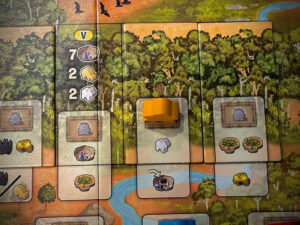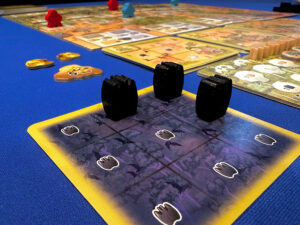 It’s not often a board game makes me want to learn German, read a book about its theme, and wish more games had bat meeples, but Atiwa, Uwe Rosenburg’s newest big box game, does just that. Atiwa is a worker placement game for 1-4 players that will take 60-90 minutes per play.
It’s not often a board game makes me want to learn German, read a book about its theme, and wish more games had bat meeples, but Atiwa, Uwe Rosenburg’s newest big box game, does just that. Atiwa is a worker placement game for 1-4 players that will take 60-90 minutes per play.
Gameplay Overview:

Set in a unique region of Ghana, Atiwa challenges players to manage a player board full of resources and build up their personal play area with new location and terrain cards to store these resources. At first glance, Atiwa’s main board will remind players of an earlier Rosenburg game, A Feast for Odin, with its myriad of worker placement spots. It can be overwhelming at first, but the choices here are simpler, much to the game’s credit. For a bit of variability, 6 of the worker placement spots are randomized at the start using tiles, which also slide to the left each round to cover up old spots and open up new ones.
Atiwa is all about the bats. During a game, players will plant trees to gain fruit which in turn will attract new bats. New bats will eat your fruit resources and excrete seeds which allow new trees to grow. Trees bear fruit that can feed your villagers. At the same time you’re building this ecological engine, players will build new villages and try to educate their families on the benefits of the bats. Players who expand too quickly or recklessly will find their families eating precious resources for food (including bats), polluting the environment, and not attracting the bats needed to keep the ecosystem intact. Players have 7 rounds to best befriend the bats.

Game Experience:
I have now played Atiwa as a solo experience, with 2 players, and at the max 4 player count. At all levels, the game moves along briskly and is easy to teach due to the straightforward iconography and included player aids. I really liked the fixed economy that each player has on their personal boards and how moving one item off and onto your cards opened up income of another type during a later phase of the game.
Thematically speaking, I loved seeing my bats fly off from my cards and onto the “bat cave” card, then planting a new tree by spending a fruit that the bats had just consumed. In stark contrast, polluting your village and terrain cards feels awful as those spots are permanently destroyed and not available for resource storage for the rest of the game. Decisions (and consequences) here make sense because they are so tied into the game’s subject matter.

Atiwa plays well at all of the player counts I have tried out and doesn’t overstay its welcome. The worker placement here doesn’t always feel restrictive, but players will still compete to get to certain spots first before settling for the worse of 2 options. The main board is modular which helps tighten up the available spots based on player count. The solo mainly involves trying to hit a target score but includes a handful of scenarios outlined in the game manual if players want to try playing to a certain strategy to win. I liked the variability this offered to me as someone who likes having a solo option available to play. The components are of good quality and highlighted by the bats. Seriously publishers, let’s find more uses for bat meeples!

There are a couple of criticisms here as well. After several plays, it feels like the possibility of discovering new strategies is low. I fear that after a few more plays that this one may be relegated to being “solved” and become a bit samey. The solo mode scenarios should help with this at least. I also don’t love the graphic design choice of the main board and the terrain cards. It’s a long-running joke that Euro games can be all beige, but in Atiwa, various shades of brown and green really do the heavy lifting in the art department. I wish they had opted for some more vibrant art befitting the beauty of the Atiwa rainforest. That being said, I have enjoyed my time with Atiwa, but worry that the theme will overshadow the gameplay after a few plays. I can’t help but think that maybe Uwe Rosenburg meant it to be that way.
If it isn’t obvious by now, I value a well-integrated theme more than clever mechanisms in my Euro games. In many Euros, theme can be an afterthought, added on during development to explain all the gears and levers the game is made up of. Not here. The designer wants you to know how important this theme is to him. So much so that the game includes a booklet about the Atiwa region including its history, geography, and people. I highly recommend players read this before playing. It also talks about the book that Mr. Rosenburg is writing about the Atiwa region and people, published in German only. Duolingo here I come!

Final Thoughts:
It’s not often I walk away from a game thinking about its theme and wanting to research it even more. Atiwa is an important game because I truly believe it was designed to educate people about a threatened ecological region and what makes it unique. That it’s also a fun game experience makes for an easy recommendation from me. For fans of worker placement, you’ll love having a wide range of actions on each turn. For fans of engine and tableau building, you’ll agonize in deciding whether you should build out your terrain cards, providing space for valuable resources, or gaining those resources immediately to fill up your board and get more income later. As a hallmark of a good worker placement game, you’ll always want one more worker than you have.
Final Score: 3.5 Stars – The theme soars here but the gameplay may be forgotten over time.
 Hits:
Hits:
• Satisfying income rounds
• Bat meeples
• Puzzle-y solo mode
• Theme
Misses:
• Bland graphic design of main player board and cards
• Lack of player interaction due to large number of spots
• Lack of variety after a handful of games
 Review by Brett Mowers
Review by Brett Mowers
Brett enjoys a wide spectrum of games with his wife and game group and is always on the hunt for the new hotness. As such, he suspects he receives more mail from Germany than his neighbors. When he’s not at the table moving meeples, he spends time with his daughter Lily and cat Loki.





















